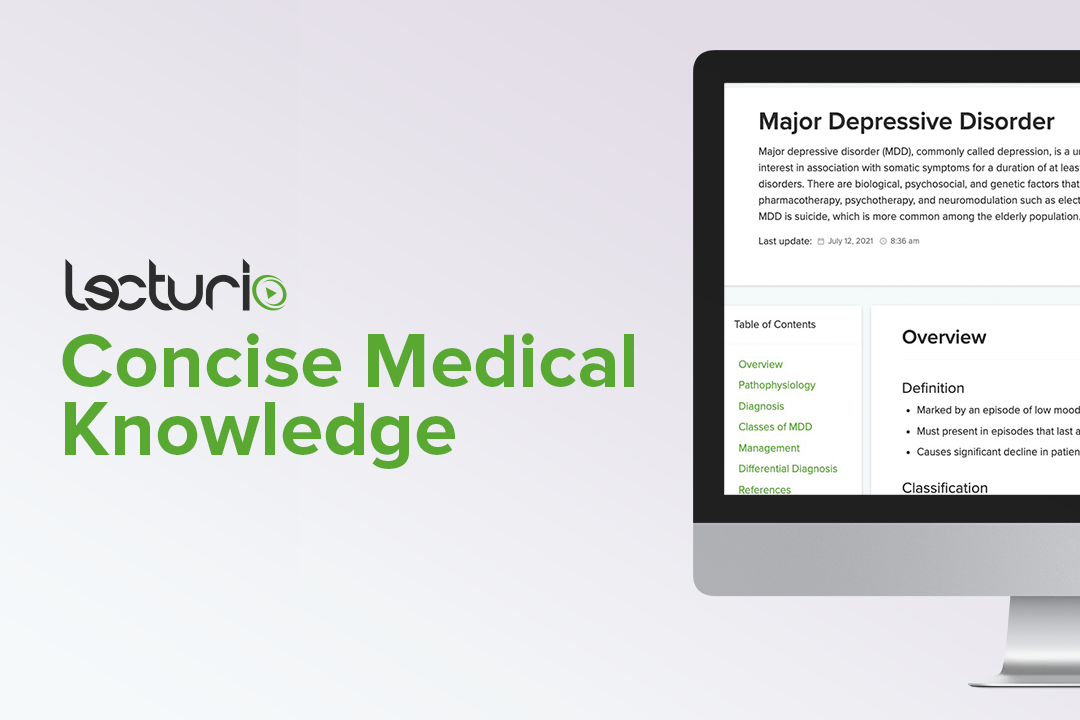Playlist
Show Playlist
Hide Playlist
Depression: Types
-
Slides Depression.pdf
-
Download Lecture Overview
00:01 So we talked earlier about the different types of major depression. 00:04 Now, we’re going to go through the criteria in a little bit more detail. 00:07 So some patients will experience an anxious depression. 00:12 And in order to qualify for this diagnosis, patients have to meet two or more of the following criteria. 00:18 So one is tension, restlessness, impaired concentration due to worry, fear that something awful might happen, fear of losing control. 00:31 Now, let’s review the type of depression called depression with atypical features. 00:36 To qualify for this diagnosis, a patient must have three or more of the following target symptoms. 00:42 So they actually feel reactive to pleasurable stimuli, meaning that if one of their former hobbies is introduced to them or a funny joke, the patient is actually able to respond appropriately with some good humor and a positive affect. 00:59 This kind of patient though will have an increased appetite or potentially weight gain, something that we call hyperphagia, eating a lot. 01:08 They may also have hypersomnia, so sleeping at least 10 hours a day and possibly even more and sleeping far more than usual when they’re not feeling depressed. 01:21 This patient also will describe having a heavy or leaden feel to their limbs. 01:26 And finally, they’ll have a longstanding pattern of interpersonal rejection sensitivity, meaning that they feel a lot of anxiety and often like an outcast or humiliated when they’re not included in social functions. 01:42 Here’s an example from clinical practice of a patient who has atypical depression. 01:48 This is Susan. 01:49 She’s a 19-year-old woman who always feels like her friends don’t like her. 01:54 So she overeats and describes feeling like her body is so heavy, she feels like she’s moving through mud. 02:02 She‘s being treated for atypical depression. 02:05 Depression wit catatonia can look like very prominent psychomotor disturbances. 02:12 So this could be either increased or decreased activity, which occur during most of the depressive episode. 02:19 You treat catatonia actually through a number of different ways. 02:24 Often antidepressants are used, but sometimes these patients will also really respond well to antipsychotics at the same time. 02:33 There’s also melancholic depression. 02:36 And to qualify for this diagnosis, patients have to have four or more of the following. 02:42 Loss of pleasure in most activities. 02:45 They’re unreactive to pleasurable stimuli. 02:49 So even when you reintroduce a hobby to them, they get no pleasure or enjoyment. 02:54 Depressed mood that’s marked by profound despondency or despair. 03:01 There’s early morning awakening with these patients. 03:04 They usually get up about two or three hours earlier than their normal time. 03:09 There’s psychomotor retardation or agitation. 03:13 They have anorexia or weight loss and excessive guilt. 03:19 Here’s a case example of melancholic depression. 03:23 This is story about Jim. 03:24 He’s 35 years old, he’s an accountant and he's suffered from depression. 03:29 He finds himself with a low mood during the week and notably when he wakes up in the morning. 03:35 He coincidentally is getting up before the sun even comes out and then he finds himself feeling restless all day. 03:42 He’s lost weight and also has felt extremely guilty over what he perceives as poor performance at work. 03:50 He’s feeling safe with no suicidal thoughts, but he doesn’t enjoy playing softball anymore with friends on the weekends. 03:58 So here’s my question to you, how do you know that Jim is suffering from melancholic depression and not another subtype? Well, here are some clues. 04:07 He has early morning awakening, feels excessive guilt, and also the fact that he’s lost interest in pleasurable activities are all signs that this is melancholia. 04:19 There can also be mixed features of depression defined by three or more of the following: Elevated or expansive mood, inflated self-esteem or grandiosity, more talkative or pressured speech, flight of ideas, increased energy or goal-directed activity, decreased need for sleep and excessive involvement in pleasurable activities that actually have a high potential for causing some negative consequences. 04:51 There’s peripartum depression, which is defined as the onset referring to a mood episode that occurs during pregnancy or within the first four weeks after childbirth. 05:04 And here’s a question for you, when is the specifier postpartum onset applied to major depression? So we just reviewed that, it’s when symptoms appear within 4 weeks of childbirth. 05:17 What’s the incidence of major depression among postpartum women? Well, the answer there is it’s about 10 to15%. 05:26 Now, it’s really important that postpartum depression be differentiated from what’s considered the normal baby blues, which are experienced in about at least half of postpartum women. 05:37 The baby blues are associated with frequent crying, periods of sadness; however, women doesn’t meet at least five or more of those SIGECAPS criteria for major depression. 05:50 There can be major depression with psychotic features and this includes delusions, which are the fixed false beliefs or hallucinations, false sensory perceptions, which can occur at any time during a depressed episode. 06:06 There can also be seasonal patterns to major depression. 06:09 A regular temporal relationship between the onset of major depression and a particular time of year for the past two years. 06:18 Remission will occur at a specific time of year. 06:21 For example, patients will often feel depressed in the winter, but then symptoms go into remission during the summer. 06:28 Here’s case example of what it can look like when somebody experiences a major depression with a seasonal component. 06:35 John is a 50-year-old salesman. 06:38 He enjoys riding his bike in the summer and going to the beach. 06:42 This winter, he came into your office at the urgency of his wife, who’s found him to be quite irritable lately. 06:49 John tells you that in addition to his short fuse, he’s feeling tired, eating more, and especially eating more sweets and carbohydrates. 07:00 And he’s feeling unmotivated. 07:02 He said this tends to happen to him every winter, but then he’s fine in the summer. 07:08 So John is experiencing the classic triad for seasonal affective disorder. 07:13 It’s irritability, increased appetite for carbohydrates and sweets, and also hypersomnia. 07:20 Dysthymia, which is now called persistent depressive disorder, is defined by having three or more of the following: A depressed mood most of the day, more days than not; decreased or increased appetite, insomnia or hypersomnia, low energy or fatigue, low self-esteem, impaired concentration or decision-making, and hopelessness. 07:48 This is a case example of somebody who could be presenting with clinical depression. 07:55 Peggy is a 45-year-old attorney who was recently widowed. 08:00 She lost her parents when she was nine and now she’s grieving the loss of her husband. 08:06 She has three children who are alive and well and very supportive to her. 08:11 That’s good because Peggy has been having some health problems lately and she’s undergoing treatment for breast cancer. 08:18 She comes to you, her primary care doctor, complaining of low mood, trouble sleeping and frequent crying that are interfering with her work. 08:28 So my question for you is what are Peggy’s risk factors for having clinical depression? Well, she’s female in gender and we know that women more often than men will experience major depression. 08:43 She had a death of her parents before age 11. 08:46 She’s currently widowed. 08:48 She has poor medical health of her own and she’s actually showing signs of clinical depression including poor sleep.
About the Lecture
The lecture Depression: Types by Helen Farrell, MD is from the course Mood Disorders. It contains the following chapters:
- Depression – Diagnosis
- Melancholia Diagnosis
- Seasonal Patterns
Included Quiz Questions
Which of the following is NOT a diagnostic criterion required for the diagnosis of anxious distress?
- Having persecutory hallucinations
- Tension
- Fear of losing self-control.
- Restlessness
- Impaired concentration.
Which of the following agents are useful in the treatment of catatonic type major depression?
- Antidepressants and antipsychotics
- Antidepressants and anticholinergics
- SSRIs and beta-blockers
- Anticholinergics and antihistamines
- Dopamine agonists and H2-blockers
Which type of depression is characterized by early morning awakening, excessive guilt, and loss of interest in pleasurable activities?
- Melancholic depression
- Seasonal depression
- Anxious depression
- Atypical depression
- Catatonic depression
Which of the following statements regarding seasonal depression is FALSE?
- It always occurs during summer.
- The same pattern of symptoms and remissions have to occur for the past 2 years consecutively for diagnosing seasonal depression.
- Remission also occurs at a specific time of the year.
- Patients often feel very tired, unmotivated, and have a craving for sweets.
- It is a temporal relationship between onset of major depressive episodes and a particular time of the year.
What is timing of postpartum onset major depression?
- Symptoms within 4 weeks of childbirth
- Diagnosis within 4 weeks of childbirth
- Diagnosis at time of childbirth
- Symptoms at time of childbirth
Customer reviews
5,0 of 5 stars
| 5 Stars |
|
5 |
| 4 Stars |
|
0 |
| 3 Stars |
|
0 |
| 2 Stars |
|
0 |
| 1 Star |
|
0 |




